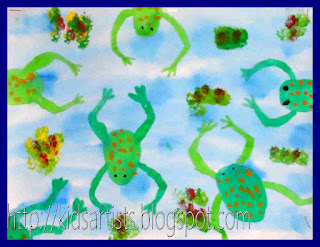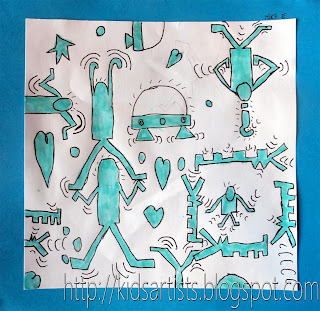Artworks are made by students of grade 3
A lesson based on a lesson from Phyl's site,
There's a dragon in my artroom, but instead of painting I decided to choose for collage. Check out Phyl's site for the paintings!
You need:
- coloured paper A4 size
- white drawing sheet A4 size
- newspaper
- ruler and pencil
- glue
- crayons
- glitter
- colour markers
Roy Lichtenstein (1923 - 1997) was an American popart artist.
He is best known for his enormously enlarged cartoons. After
his art studies in New York and Columbus Liechtenstein teached art himself. In his spare time
he painted abstract paintings and made parodies of American art from the twenties. In1960 he came into contact with Claes Oldenburg and the style elements from advertising and comic strips. He started to use use grids, dots, black outlines and bright colours, the style who made him famous.
From 1962 Lichtenstein used the works of Monet, Picasso
and Mondrian as the inspiration for his art and he paints sunsets in their style. Most of his work however
is based on advertisements and cartoons.
.JPG) Show artwork of Liechtenstein on the digital board and discuss the characteristics
Show artwork of Liechtenstein on the digital board and discuss the characteristics: primary colours sometimes with green, text
balloons, raster
dots as we know from newspaper photographs and thick black outlines. Show comic balloons from Lichtenstein and discuss them.
In this lesson students create a comic balloon like Lichtenstein did. Choose for a basic form, a star or cloud. See my 'how to draw a star step by step' below.
Cut this or cloud out of coloured paper. Cut another cloud or star from a newspaper. Draw an action word on the white sheet and colour with markers. Cut this word. Create composition and paste the parts of the artwork. Draw action stripes with black crayon or use glitter.
How to draw a star:
1. Draw a circle.
2. Draw lines from the edges to the circle, using pencil and ruler. See the black lines in the picture.
3. Draw lines from the same places but make them diagonal. See the red lines in the picture.
4. Cut the parts between the triangles, the blue pieces in the picture.
.jpg)
.jpg)
.jpg)
.jpg)
.jpg)


.jpg)
.jpg)
.jpg)
.jpg)


.jpg)




.jpg)
.jpg)
.jpg)
.jpg)
.jpg)
.jpg)

.jpg)
.JPG)


.jpg)
.jpg)
.jpg)
.jpg)
.jpg)
.jpg)
.jpg)
.jpg)
.jpg)
.jpg)
.jpg)
.jpg)
.jpg)
